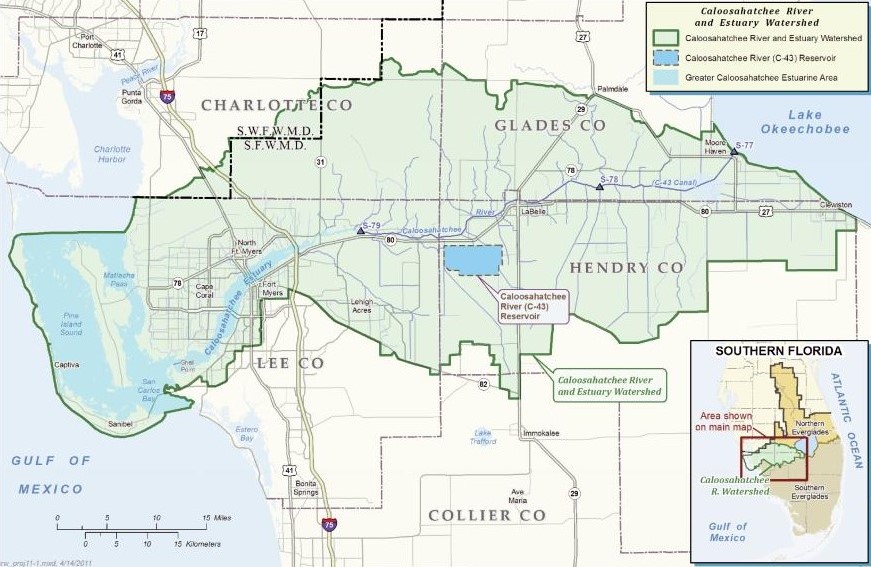
The Comprehensive Everglades Restoration Plan involves restoring, protecting, and preserving the water resources of Central and South Florida. As part of this effort, the C-43 West Basin Storage Reservoir will be developed to store and manage runoff as well as regulatory releases from Lake Okeechobee.
The Comprehensive Everglades Restoration Plan involves restoring, protecting, and preserving the water resources of Central and South Florida. As part of this effort, the C-43 West Basin Storage Reservoir will be developed to store and manage runoff as well as regulatory releases from Lake Okeechobee. This particular project targets reestablishing more natural conditions in the Caloosahatchee Estuary.
During the wet season, runoff and discharges retained in the Reservoir will no longer reach the Caloosahatchee Estuary, reducing the frequency of undesirable salinity range, which, in turn, revitalize fish and oyster habitats. During the dry season, the water stored in the Reservoir will provide essential flow to the Estuary, improving the salinity balance and promoting the survival of ecological communities.
The Caloosahatchee River (C-43) West Basin Storage Reservoir Project is located on 10,700 acres of former farmland located in Hendry County, Florida. Once completed, the project will hold approximately 170,000 acre-feet of water with depths ranging from 15 to 25 feet.
In November of 2017, Enviro-Tech Systems, Inc. was awarded the preparation phase of this project by the South Florida Water Management District. Primary objectives were to mechanically mow and clear all vegetation within 2,000 linear feet of the perimeter property line and a 2,000 linear foot wide north/south transecting line. Additionally, work included leveling and grubbing all trees exceeding 4 feet in height from the interior of the project site. This translated to making 10,500 acres of land for the Reservoir development-ready.
During the pre-development phase of the project, the following permits and plans were obtained and developed:
Generic Permit for Stormwater Discharge from Large Development Activity was obtained through the FL Department of Environmental Protection.
Due to the sheer size of the project, the site was divided into 97 labeled zones, ranging in size from 17 acres to 434 acres. Meeting areas, equipment storage and laydown areas, and ingress and egress routes were planned and disseminated to all crews. Crews of at least two workers were dispatched to adjacent zones to Begin clearing and grubbing activities. The material generated from these activities were then gathered into piles. At this point, a District representative was contacted to verify the clearing and grubbing activities for the block were completed.
With Certified Pile Burners and prescribed acreage burners on staff, ETS proposed burning to efficiently handle the masses of debris from the clearing and grubbing process and neutralize more of the seeds dispersed from the grubbed trees. This proposal was approved by the SFWMD. Due to the environmental sensitive nature of the site, ETS developed a Burn Plan detailing the methods and precautions to be undertaken.
Additionally, wildlife logs were submitted immediately to District staff should a threatened or endangered species be observed on-site. These logs indicated the labeled zone in which the species was observed and the action undertaken to ensure its safety.
Once the District representative approved a zone and conditions allowed, ETS’ Certified burners would conduct pile burns. At this point, a District representative would once again be contacted to verify the zone had been completed.
As part of a Change Order, the SFWMD requested that ETS also developed a Quality Control/Quality Assurance Testing Facility, which included a 2,400 SF steel building and related site improvements. This work included the design and erection of a 30’ x 80’ x 14’ steel metal building with concrete slabs and dual zone air conditioner, electrical and site lighting, three 8’ x 20’ storage containers, lightning protection and grounding, 3,000 gpd water treatment and reverse osmosis system with appurtenances, building permits, four hose bibs, wash sink and counter, five concrete shaker tables, gate, and fencing.
The experience gained by ETS working with large operations evolving expansive tracts of land in Central and South Florida’s unique environments gives the company an edge in performing projects that involve extensive amounts of earthwork. ETS’ ability to apply strategic and innovative methods to efficiently accomplish earthwork activities and their use of cost-effective procedures provides an unparalleled benefit to their clients. This particular project for the SFWMD was completed months ahead of schedule for a fraction of the cost submitted by other bidders.



